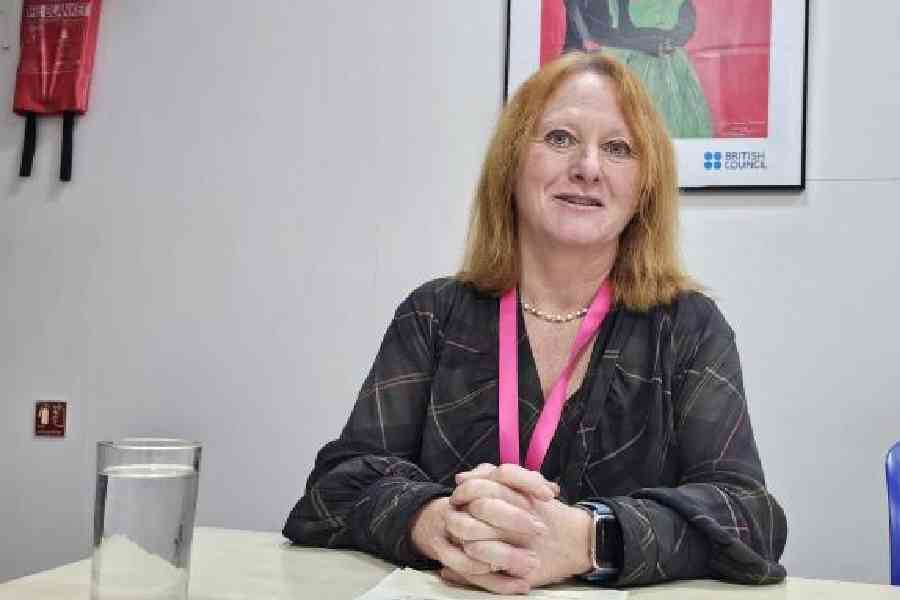Culture Connect


Sharon Tonner-Saunders has won multiple awards for using performing arts and technology in educational practices and for implementing her methodology in global projects for young learners.
“You don’t have to be a musician to use music in teaching. It is a tool to express yourself and enhance learning,” she told The Telegraph. Tonner-Saunders is a lecturer in technologies-ICT and music in the school of education at the University of Dundee, Scotland. She was in Calcutta as a British Council ambassador to deliver lectures in universities as part of their Great Talk series.
Asking children to sit still in class and listen, she pointed out, was going against their nature. “Children don’t speak first, they sing; they don’t write first, they draw. If you create a musical story with whatever you are teaching, they can retain it more easily,” she said.
Pointing to a landscape painting on the wall, she said she would typically ask her students to imagine themselves in that environment and come up with songs of birds and the sound of breeze. The sounds they produce could be recorded and added to the photograph on the computer to bring the picture alive.
Born into a musical family, Tonner-Saunders had started out as a primary school teacher. A quest to bring the world into her class made her reach out to schools in other countries. “If my students wanted to learn about a country, I did not want them to open a book. I contacted a school from the country in question to send a box with things representing their culture. While we would send tokens of jute, jam and journalism, things Dundee is known for, we got a baseball bat and magazines from an American school. It was as if America came to us in that box,” she said.
In 2008, she got a chance to attend a workshop in Estonia, where teachers from across Europe were placed in groups and asked to create a project whereby they could stay connected.
“I had France, Spain, Germany, Croatia and Hungary in my group. I realised they were all speaking in English. To let them retain their linguistic identity, I came up with a project called Voices of the World. A simple song in English, say Twinkle twinkle little star, would be translated by each participating school into their mother tongue and the recording would be sent to me. At the end of the month, students would check the project website to see how the song sounded in every language,” she said.
Though it started with six schools, the project became so popular that within a year, the participating schools numbered 100. Said Tonner-Saunders, “My initial plan was to take one school from each country but when the requests started coming, I realised how much dialects differed from region to region.”
One day, while supervising the teaching in a primary school, she saw a little boy with hearing disability attend a class with others. A signer was assigned to him. Tonner-Saunders noticed that other children had started using signs while speaking to him. “It struck me that sign language itself would be beyond the skill set of a primary school teacher. But I encouraged the use of Makaton, which simply involves gestures to support the spoken word, like indicating a downward movement when asking one to sit. Children learn faster this way,” she said. Makaton is the name for the use of signs and symbols alongside speech and written words to support communication.
This realisation made her conceive the Hands of the World project. “I was still using music but I would make the singers use hand gestures too,” she said. So, if students of a British school said hello with a wave of a hand, French students would respond with a similar hand movement and say bonjour.” It is meant to break down communication barriers through the use of music and Makaton.
Tonner-Saunders recorded entire songs this way. “I picked a simple song — A Million Dreams from the film The Greatest Showman. All participating schools sang a line each. I put the recordings together in a video,” she recalled.
This project won the British Council’s National eTwinning Award for best project in the UK twice — in 2019 and 2020.
While she had conceived of the project to unite students from diverse cultures across the world, classrooms in Europe now are becoming increasingly diverse. She said, “Half of our students at the university level are international. Schools too have more and more students with whom teachers are not being able to communicate.”
“Ever since the conflict [in Ukraine] began, the biggest chunk has been those displaced, especially from Ukraine. These students are coming in without any knowledge of English. The challenge is to prepare them to take up English as a second language,” she added.
Students being exposed to a single culture, she believes, is resulting in a blinkered view of the world. Tonner-Saunders said, “We need to foster intercultural sensitivity.”